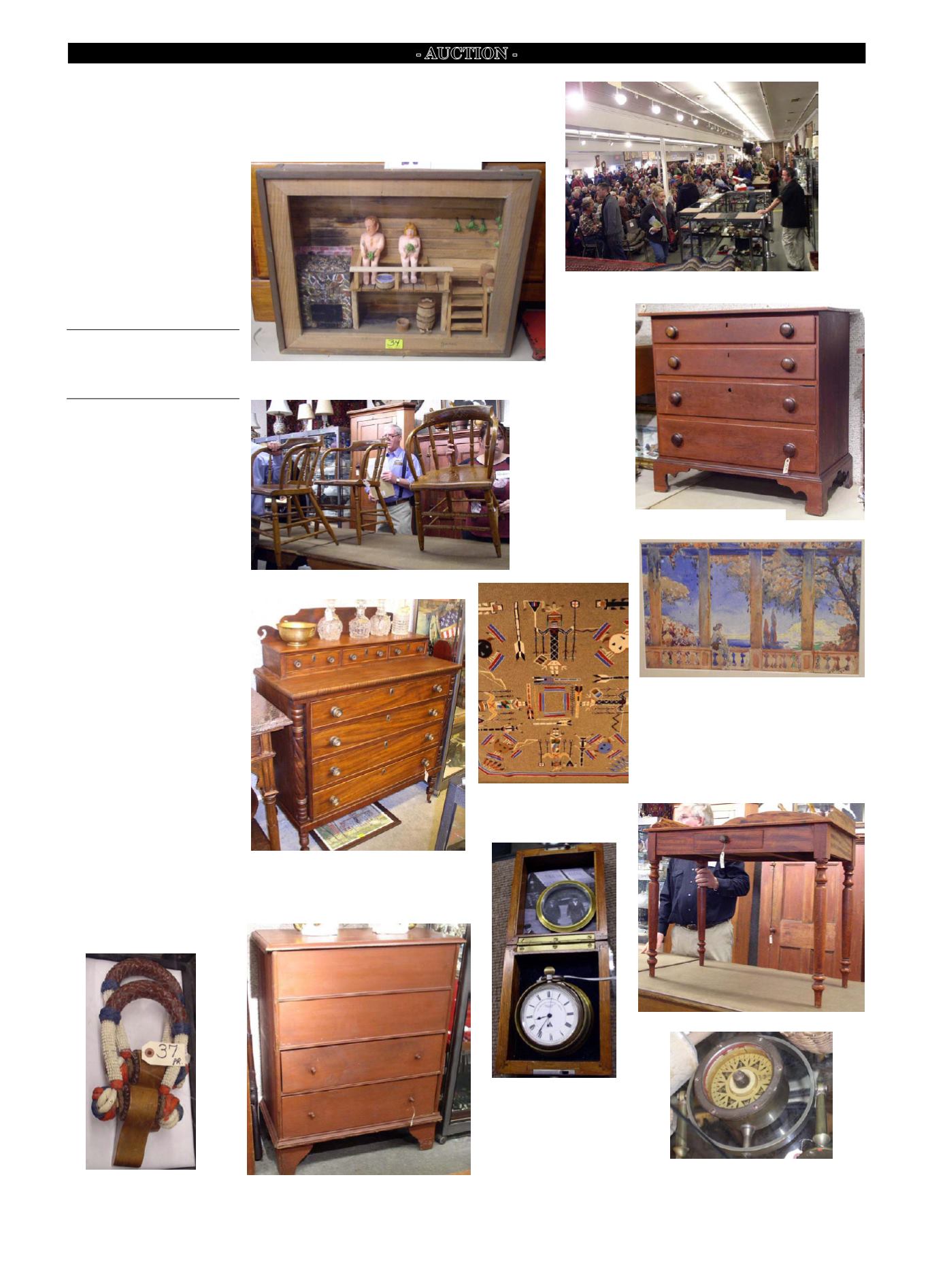

Maine Antique Digest, April 2015 15-D
- AUCTION -
☞
A
typically frosty wintry morn-
ing on January 1 didn’t stop a
huge crowd from filling Robert
Foster’s auction gallery in Newcastle,
Maine. For decades, Foster’s winter
auctions have been drawing mobs
of bidders. “Probably the biggest
crowd we’ve ever had here,” Foster
announced at the commencement of
the sale.
Bidders saw a lot of red, as in red-
painted country furniture and folk art.
A red and black grain-painted Sher-
aton server with nicely turned legs
and a three-sided splash around the
top sold for $385 (includes buyer’s
premium). Adark red and black grain-
painted Sheraton one-drawer drop-
leaf harvest table, 55½" long, brought
a respectable $550. And a simple
and straight-lined Connecticut Val-
ley Chippendale four-drawer chest in
old dry red finish with a widely over-
hung top, wooden knobs, and a cutout
bracket base topped the red paint lots.
It was the best piece of country fur-
niture in the sale, and it sold well for
$1980. Near the end of the sale came a
nifty red-painted and carved wall box,
with two rearing horses pawing an
eagle and shield. The lower half had
some faint gilding and an even fainter
signature reading “Nathan Dunellen”
or “Nathan Dunmiller.” I wasn’t able
to track down the name, but the little
folk art gem brought $137.50.
Some other interesting folk art
pieces drew solid attention without
pulling out-of-reach prices. Acontem-
porary folk art diorama sculpture by
Unto Jarvi (1908-1991) showed a cou-
ple in the altogether, happily enjoying
a sauna, complete with the traditional
birch boughs. Around 1919 Jarvi left
his birthplace of Saaksmaki, Finland
and immigrated to Michigan’s Upper
Peninsula. He began painting and
sculpting around 1959, creating fig-
ures he called “Jarvi’s Little People.”
After retiring to Auburn, Kentucky,
in 1971, he began to produce more
of these diorama-type sculptures, and
his works were included in a 1991
exhibition by the Owensboro (Ken-
tucky) Museum of Fine Art,
Ken-
tucky Spirit: The Naive Tradition
. The
diorama offered by Foster was signed
and dated 1976, and it fetched $385.
For more information, visit Foster’s
Web site
(www.fosterauctions.com)
or call (207) 563-8110.
Robert L. Foster, Newcastle, Maine
Big Crowd Sees Red at Foster’s
by Mark Sisco
Bidders saw a lot
of red, as in red-
painted country
furniture.
Folk art diorama carving by Kentuckian Unto Jarvi (1908-1991) of
a couple enjoying a traditional sauna, $385.
A matched set of six
captain’s chairs (three
shown), each decorated
with a Masonic level and
square symbol on the
crest, hit $550. They were
sold by the L.F. Wehr-
mann Furniture Com-
pany of Cincinnati, Ohio,
and probably dated from
the late 19th century.
Red and black grain-painted Sheraton server, $385.
This framed watercolor, signed and dated lower
right “A. Thieme 1923” for Massachusetts painter
Anthony Thieme (1888-1954), appeared to give
homage to Maxfield Parrish. It has a seminude
young woman seated on the balustrade of an open-
roof courtyard and staring out to the azure horizon.
The selling price was a moderate $467.50, perhaps
because the subject was not in keeping with what
we usually expect from Thieme. It had no boats, no
crashing surf, and no scenic harbors.
Foster packs them in like nobody else. As always, the spacious Route
1 hall was filled to overflowing.
Stepback mahogany Sheraton chest with uniform
matching graining on the drawer fronts, full spi-
ral-turned columns, and hints of tiger graining on
the top edge, $990.
Connecticut Valley Chippendale four-
drawer chest in dry red paint, $1980.
A 6'5" x 4'6" Navajo rug showing
kachinas, sun symbols, and sev-
eral animal pictographs rang out
at a strong $1870. Foster photo.
A red-painted blanket chest on a cutout bracket
base, with a molded lid and tiny wooden clothespin
knobs, ended at a moderate $275.
This sterling silver pocket
chronometer
by
Sheffield
Goldsmiths Co. of England was
in a brass and mahogany case
holding an image of the Gold-
smith store. It sold for $1100.
A pair of patriotically painted
red, white, and blue sea chest
beckets on carved wooden
mounts ended at $330.
One of my “moles in the organization” suggested that this brass
gimbaled Sestrel compass might be a hot item. “Sestrel” was a
trademark for Henry Browne & Son of Barking and London,
England. The intelligence proved questionable when the compass
sold for a not-over-the-moon $247.50.










